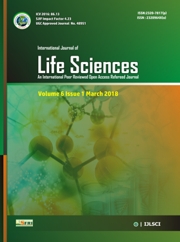RESEARCH ARTICLES
Volume 6 |Issue 6| Nov-Dec 2018 First published: 31 December 2018
Seasonal and quantitative distribution of Rotifers in Isapur Dam, District,Yavatmal Maharashtra, India
Jadhao VB
Mangalabai Naik Secondary and Higher Secondary School Dhanora (Wad) Tq.Yavatmal Dist.Yavatmal, (M.S.) India
Email:
Abstract
Keywords: : Isapurdam, Seasonal, Zooplankton, Rotifers.
Editor: Dr.Arvind Chavhan
Cite this article as:
Jadhao VB. Seasonal and Quantitative distribution of Rotifers in Isapur Dam,
District, Yavatmal Maharashtra, India. Int. Res. Journal of Science & Engineering, 2018, 6(6): 281-285.
References
1. Tyor, A. K.,Chopraand, G., SeemaKumari(2014): Zooplankton diversity in Shallow Lakeof Sultanpur National Park, Gurgaon Haryana.Int. J. Appl.Biol.Pharm Technol.,5(1):35-40.
2. Sharma, C. and Tiwari, R.P.(2011): Studies onzooplanktons of fresh water reservoir at Lonydam. TheontherRewa (M.P.) Internationaljournal of pharmacy and life.
3. Herzig, A. (1987): The analysis of planktonicrotifer populations: A plea for long–terminvestigations. Hydrobiologia, 1471: 63-180.
4. Starkweather, P. L. (1987): Rotifera. In T. J.Pandian and F. J. Vernberg (Eds.), Animal energetics. Vol. 1, Protozoa through InsectaAcademic Press, Orlandodo 159–183.
5. Walz, N. (1997): Rotifer life history strategiesand evolution in freshwater planktoncommunities. In B. Streit, T. Städler, and C. M.Lively (eds.), Evolutionary ecology offreshwater animal, BirkhäuserVerlag, Basel,119–149.
6. Boltovskoy, D. and Mazzoni, H.E. (1988): The effects of sampling gear and environmental conditions on the abundance estimates of freshwater zooplankton. Rev.Hydrobiol. Trop. 21, 21-34.
7. Zabbey, N., Sikoki, F. D. and Edoghotu, J.(2008): Plankton assemblages and environmental gradients in the middlereaches of the Imo river, Niger Delta,Nigeria.African Journal of Aquatic Science; 33(2):241- 248.
8. Adoni A. D. (1985): Workbook on limnology; Indian MAB Committee Dept. of environment, Govt. of India.
9. APHA (1989): Standard methods for the examination of water and wastewater. 17th Ed. American Public Health Association, Washington D. C., 1467
10. Pejler, B. (1957): Taxonomical and ecological studies on planktonic form of rotifera from central Sweden. K. Suanska, Vetensk., 6 (7):52 pp.
11. Michael, R. G. (1968): Studies on the Zooplankton of a tropical fish pond, Indial. Hydrobiologia, 32:47-68.
12. Seenayya, G. (1973): Ecological studies in the plankton of freshwater Ponds of Hyderabad, India. III. Zoo and Bacteria, Hydrobiol,41(4):529-540pp.
13. Sharma, N. and Sahai, Y.N. (1990): Some observations on the plankton population of Jari reservoir near Allahabad (U.P) and their Significance to fisheries. Proc. Nat. Workshop. Reservoir. Fish, 131-138.
14. Adholia, U.N. and A. Vyas (1993): Ostracod community in relation to Limno chemistry of Mansarovar reservoir, Bhopal J. Nat. Conserve, 5 (2), 1-12.
15. Bais, V. S. and Agrawal, N. C. (1995): Comparative study of zooplankton pectrum in the Sagar Lake and Military Engineering Lake. J. Envir Biol. Muzaffarnagar, 16(1):
16. Chapman,M.A.(1972): Calamenalucasi (copepods;calnoida)and other zooplanktons in two Rotorua,Newzeland,lakes.Int.Rev.Ges.Hydrobiol.58;79- 104

